| Model Paper: 1
PHYSICS
CBSE - XII |
General instructions:
1. Questions 1-8 carry 1 mark each.
2. Questions 9-18 carry 2 marks each.ss
3. Questions 19-27 carry 3 marks each.
4. Questions 28-30 carry 5 marks each.
Q 1 Is electric flux a scalar or vector quantity? Give its SI units.
Ans. 1 Electric flux is a vector quantity. Its SI unit is
Newton meter2/ coulomb.
Q 2 By which wave phenomenon can we distinguish light waves from sound
waves?
Ans. 2 Polarization.
Q 3 What is a wave front?
Ans. 3 Wave front is a surface over which the oscillations in a
wave have the same phase. The surface is normal to rays in an isotropic
medium.
Q 4 What will be the effect on the drift speed of an electron in a
metallic conductor if the temperature of the conductor is increased?
Ans. 4 The drift speed will decrease due to the increase in the number
of collisions thus decreasing the time constant.
Q 5. A magnetic needle which is free to rotate in a vertical plane,
orients itself with the axis vertical at a certain place on the earth.
What are the values of horizontal component of earth's magnetic field
and angle of dip at this place?
Ans. 5 The horizontal component of earth's magnetic field is 0°
and the angle of dip is 90°.
Q 6 Write down the names of waves used in RADAR. What is the range
of their wavelength?
Ans. 6 Sound waves with microwave frequencies are used in RADAR. The
range of the wavelength is approximately 1m to 10-3m.
Q 7 Give an example of a non-ohmic device, which shows negative resistance.
Ans. 7 Thyristor.
Q 8. Two potentiometers X and Y showing variations of potential difference
with length as shown in the figure below. Which one of the potentiometers
is more sensitive?
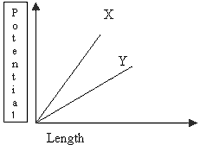
Ans 8. The Y-potentiometer is more sensitive.
Q 9. Define Kirchoff's law for an electric network.
Ans. 9 There are two laws given by Kirchoff,
1. The algebraic sum of the electric currents that meet at any point in
a network is zero.
2. In any closed electric circuit the algebraic sum of the products of
current and resistance in each part of the network is equal to the algebraic
sum of the electromotive forces in the circuit.
Q 10 What is interference of light? Write down the necessary conditions
for the interference of two light waves.
Ans. 10 Interference of light is a phenomenon arising when two beams
of coherent lights, which have traveled different distances, are superimposed.
The beams should be approximately of equal intensity.
The conditions are:
1. The waves should be coherent.
2. The beams should be of nearly same intensity.
3. The beams should not intersect at too large an angle.
Q 11 Write down the principle of reversibility of light. Hence prove,
1m2 = 1 / 2m1
Ans. 11 According to the principle of reversibility, if a ray of light
is reversed, it always travels along its original path.
If 2m1 is the refractive index from medium 1 to
medium 2 then,
2m1 = sin i/sin r
Where i and r are the angles of incidence and reflection respectively.
From the principle of reversibility, if the ray of light is reversed its
original path will be retraced.
1m2 = sin r/sin i
or, 1m2 = 1 / 2m1
Q 12 Radius of curvature of each surface of a convex lens of refractive
index 1.5 is 50 cm. Calculate its power.
Ans. 12 R = 50 cm = .5 m
f = (½) * R
f = 0.25 m
P = 1/f
P = 1/0.25 = 4 diaptors.
Q 13 Derive a relation between surface temperature of the sun with
the solar constant.
Ans. 13 Consider sun to be a black body at temperature T and radius
R0 at the center of a hollow sphere of radius r, r R0.
Surface area of the hollow sphere = 4pr2.
All the energy emitted by the sun falls normally on the inner surface
of the hollow sphere. If S is the solar constant, the solar luminosity
is given by,
L0 = 4pr2S
According to Stephen's law, the energy emitted per sec per unit area is
given by,
E = s T4
Surface area of sun = 4pR02
Total energy emitted per second by the sun = 4pR02E
= 4pR02s T4
As solar luminosity is also equal to the total energy radiated per second
by the sun. Therefore,
4pR02sT4 = 4pr2S
T = [r2S/R02s]1/4
Knowing the value of S, s, r and R0, T can be determined.
Q 14. A sphere S1 of radius R1, encloses a total
charge q. If there is another concentric sphere S2 of radius
R2 (R2 R1) and there be no additional
charges between S1 and S2. Find the ratio of the
electric flux through S1 and S2.
Ans. 14 Flux through S1 = ± 4pR12E
(r)
Flux through S1 = ± 4pR22E (r)
Ratio = (R1/R2)2
Q 15 A voltaic cell has an emf of 2V. Is there a net field inside
the cell when,
1) Circuit is open.
2) Circuit is closed.
3) A steady current is drawn from it.
Ans. 15 1. When the circuit is open there is no net electric field
inside the circuit. A field of non-electrostatic origin balances the electrostatic
field due to the plates.
2. When the circuit is closed current flows in the direction of electrostatic
field outside and in the opposite direction of electrostatic field inside
the cell. There is a net field inside the cell opposite to the electrostatic
field.

Q 16 Calculate the resistivity of material of a wire 10m long, 0.4
mm in diameter and having a resistance of 2W.
Ans. 16 Data provided,
R = 2 W
l = 10m
d = 0.4mm
A = 0.1256 mm2
From the following formula, r is easily obtained.
R = pl/A
r = 2.512 * 10-8 Wm
Q 17 A charged oil drop falls due to gravity with a speed V. This
drop is held stationary by applying electric field in a Millikan's setup
and is found to have two excess electrons. Suddenly it is observed that
the drop moves up with the same velocity V. Why does this happen? Write
down the relevant mathematical expression.
Ans. 17 The drop moves upward due to the attraction of the upper plate
as the capacitor plates are charged to a high potential difference. The
drop has two excess electrons, which it picks up from the ionized air.
The mathematical expression is,
q = [mg/E] tg[1/te + 1/tg]
where q is the charge, E is the electric field, tg is the time
taken by the droplet during free fall and te is the time taken
by the droplet when moving in the electric field.
Q 18 In a n-p-n tr
Ansistor, if the emitter and the base have the same
doping concentration, how will the collector and base current be affected?
Ans. 18 The n-p-n tr
Ansistor has its emitter-base junction forward
biased by connecting the emitter to the negative terminal of VEB
battery and the p-type collector is reverse biased by connecting it to
the positive terminal of VCB battery as shown in the figure
below.
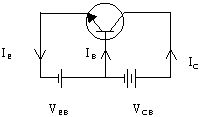
The forward biasing of emitter base circuit repels the electrons from
the emitter towards the base, setting up emitter current IE.
As the base is very thin and lightly doped, a very few electrons (»1%)
from the emitter combine with the holes of the base, giving rise to base
current IB. and the remaining electrons (»99%) are pulled
by the collector which has a high potential. The electrons are finally
collected by the positive terminal of the battery VCB giving
rise to collector current IC.
As soon as an electrons from the emitter combines with a hole in the base
region, an electron from the negative terminal of battery VEB
enters the emitter and an electron from the base enters the positive terminal
of VEB. This sets a base current IB. Similarly,
corresponding to each electron that goes from collector to the positive
terminal of VEB, an electron enters the emitter from negative
terminal of VEB. Hence,
IE = IB + IC
Q 19 What is a thermocouple? Draw the graph of variation of thermo
emf generated as a function of temperature of hot junction. The cold junction
is at 0 °C. Also give two applications of thermo couple.
Ans. 19 When two metals are joined together and the two junctions
are maintained at two different temperatures, then current flows and the
metals are said to constitute a thermocouple.
| Graph of variation of thermo e.m.f generated with temperature |
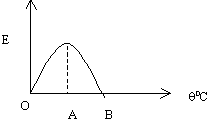
Applications: In measurement of temperature and in solar batteries.
Q 20 Draw the logic symbol and write the truth table of OR gate. With
the help of a circuit diagram describe the realization of OR gate using
semiconductor devices.
Ans. 20
| |
Circuit symbol of a
2-input OR Gate |
|
 |
| A |
B |
Y |
| 0 |
0 |
0 |
| 1 |
0 |
1 |
| 0 |
1 |
1 |
| 1 |
1 |
1 |
| Circuit Diagram of OR Gate |
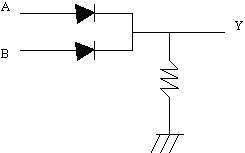
Q 21 Define the current sensitivity of a moving coil galvanometer.
On what factors does it depends? If in a galvanometer current sensitivity
is increased by 1.5 times, how will the voltage sensitivity be affected?
Ans. 21 The current sensitivity of a moving coil galvanometer is defined
as:
1/G = NAB/k
where k is the constant of suspension
B is the magnetic field.
A is the area of the coil {length * breadth}
N is the no. of turns of the coil.
From the relation it is clear that the sensitivity depends on N, B and
A.
Vsen = Isen R (equation I)
V'sen = I'sen R' (equation II)
Dividing equation II by I, we have
V'sen/ Vsen = (I'sen/ Isen)(R'/R)
= (1.25 I /I)(1.5 R/R)
V'sen = 1.875 Vsen
Q 22 The voltage across a cathode ray gun is 500 V. Calculate,
1) The energy gained by the electrons.
2) The speed of the electrons.
3) The momentum of the electrons.
Ans. 22 Energy = ½ mv2 = eV = 1.6 * 10-19
* 500 = 8.0 * 10-17 eV
v = [2eV/m]1/2
= [2 * 1.6 * 10-19 * 500 /9.1 * 10-31]1/2
v = 1.3 * 107 m/sec
Momentum = mv =9.1 * 10-31 * 1.3 * 107 kg m/sec.
Q 23 A series LCR circuit consists of R = 10 W, Xe = 60 W and an inductance
coil. The circuit is found to resonate when put across 300 V, 100 Hz supply.
Calculate induction of the coil and current in the circuit at resonance.
Ans. 23 Given that as LCR circuit resonates when put across a 300
V, 100 Hz supply.
R = 10 W
XC = 60 W
At resonance,
w2 = 1/LC
XC = 60 W = 1/wC
n = 100 Hz, XC = 60 W
Therefore, w = 2pn = 3.14 * 2 * 100 = 628.2
C = 1/w XC
= 1/ 628.2 * 60 + 2.653 * 10-5
Now, L = 1/w2C
= 1/[ * (3.14)2 * (100)2 * 2.653 * 10-5]
= 9.55 * 10-2
I = V/R = 300/10 = 30 amps
Q 24 Monochromatic light (l = 589 nm) is incident from air to water
surface. What are the values of wavelength, frequency and speed of reflected
and refracted light?m = 1.33
Ans. 24 Data given,
l = 589 nm
m = 1.33
m = Vair/Vwater = 1.33
Vwater = Vair/1.33 = 3 * 108/1.33 = 2.25
* 108 m/sec
lair = 589 nm = 589 * 10-9 m
C = n l
n = [3 * 108]/[589 * 10-9]
lwater = Vwater/n
= [3 * 108/1.33][589 * 10-9/ 3 * 108]
= 4.42 * 10-7 m
Therefore,
Speed of reflected light = 3 * 108 m/sec
Speed of refracted light = 2.25 * 108 m/sec
Q 25 The half-life of Polonium is 138 days against a decay. What fraction
of a sample of a pure Polonium will remain undecayed after 276 days?
Ans. 25 It is given that the half-life period of podium is 138 days
against a decay. From the definition of half-life it is obvious that half
of the initial Polonium will be decayed in 138 days. Another half of the
remaining half will decay in the next 138 days. That me
Ans after 276 days,
only one fourth of the initial podium remains undecayed.
Q 26 With a circuit diagram explain the use of a n-p-n tr
Ansistor
as an amplifier in common emitter mode. Show the phase relationship between
collector and base voltage.
Ans. 26 The figure below shows the use of n-p-n tr
Ansistor as a common
emitter amplifier. The emitter is common to both input and output circuits.
The emitter is forward biased by battery VBB and the collector
is reversed biased by the battery VCC. This decreases the resistance
Rin of the input circuit and increases the resistance Rout
of the output circuit. The low a.c. input signal VI is superimposed
on the forward bias VBE. A load resistance RL is
connected between the collector and the d.c. Supply and the amplified
output is obtained between the collector and the ground.
Circuit diagram of tr
Ansistor amplifier in the common-emitter
mode. |
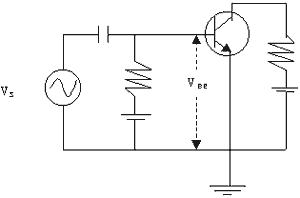
When current IC flows in the output circuit, the potential
drop across load resistance is ICRL. Hence the output
voltage is,
V0 = VCE = VCC - ICRL
When the input signal is fed to the base-emitter circuit, the base emitter
voltage changes. This changes the emitter current IE and hence
the collector current IC. the output voltage V0
varies in accordance with the above relation. These variations in the
collector voltage appear as amplified output.
Phase relationship between input and output signals. When an a.c. signal
is fed to the input circuit, its positive half cycle increases the forward
bias of the circuit which in turn increases the emitter current and hence
the collector current. The increase in collector current increases the
potential drop across RL, which makes the output voltage V0
less positive or more negative. So as the input signal goes through its
positive half cycle, the amplified output signal goes through a negative
half cycle. Similarly as the input signal goes through its negative half
cycle, the amplified output signal goes through its positive half cycle.
Hence in a common emitter amplifier, the input and output voltages are
180° out of phase or in opposite phases.
Q 27 Explain the working of a simple microscope and show that its
magnification is given by, m = 1 + D/f.
Ans. 27 A microscope consists of a converging lens of short focal
length. The object is placed within the focal length of the lens so that
an erect, magnified and vertical image of the object is formed. The closest
comfortable distance for viewing the object is the near point [D = 25
cm]. The magnification is given by M,
M = image distance/object distance = v/u = v[1/v - 1/f]
In this case v is negative and is equal in magnitude to D.
M = 1 + D/f
Q 28 What are the Bhor's postulates on atomic model. Derive an expression
for the total energy of an electron in the nth orbit.
Ans. 28 Bhor's postulates:
1. Electrons move in circular orbits around the nucleus called the stationary
states. It restricts the stationary states to those circular orbits in
which the angular momentum is an integral multiple of [h/2p].
2. An additional postulate is that : in violation to electrodynamics,
accelerated motion of electronic charge in these orbits is not accompanied
by emission of electromagnetic radiation.
3. When a hydrogen atom makes a tr
Ansition from a state with quantum number
nI to the state with quantum number nf (nf
< nI), then it does by emitting a photon of energy hn which
is the difference in energies of the two states.
The energy of electron in the stationary state is the sum of its kinetic
and potential energies.
K.E. = ½ mv2
P.E. = - e2/4pe0r
The total energy E = ½ m v2 - e2/4pe0r
According to Bhor, a stationary state has its circumference equal to an
integral number of De Broglie wavelengths.
So, 2pr = nl = nh/mv
mvr = nh/2p
v = nh/2pmr
Also, mv2/r = e2/4pe0r
Therefore, v = 1/n[e2/4pe0r][2p/h]
And r = n2/m [h/2p]2[4pe0r/ e2]
a is the fine structure constant,
c is the velocity of light,
h is Planck's constant,
r is the radius of the orbit,
e is the elctronic charge.
Q 29. If C1 = 3 pf and C2 = 2 pf, calculate the
equivalent capacitance of the given network between points A and B.

Ans. 29 We start solving the circuit from the right hand side.
All the three capacitors of capacity C2 2pf each are in series.
This gives the equivalent capacitance,
1/C = 3/C2 = 3/2 pf. C = 2/3 pf
This is in parallel with the next C2 capacitance, which gives an equivalent
capacitance of 8/3 pf.
Now the remaining three capacitors are again in series, which gives an
equivalent capacitance of 1/(1/3 + 1/3 + 3/8) or 24/25 pf.
Q 30 A small city having a demand of 880 kW of electric power at 220
V is situated 15 km away from electric plant generating power at 440 V.
The resistance of the cable is 15 W. The city gets power through a 4400-220
V step down tr
Ansformer at the substation. Calculate,
1) Power loss in the form of heat.
2) How much power the plant must supply (assuming the power loss in the
form of losses is zero).
3) Voltages drop in the line.
Ans. 30 The current in the line can be given by, 880 * 1000/4400 =
200 A
1. The power loss is given by H = I2R = (200)2 *
15 = 600 Kw
2. The plant should supply a total power of 880 + 600 = 1480 Kw
3. The voltage drop is given by, 200 * 15 = 3000 V.
|








